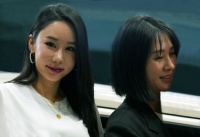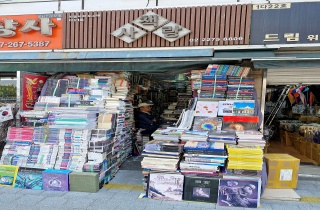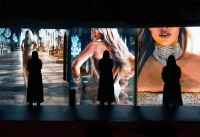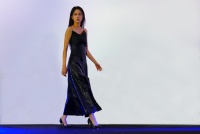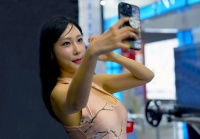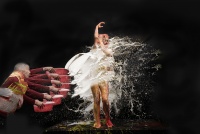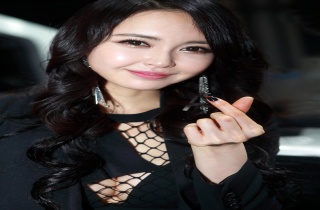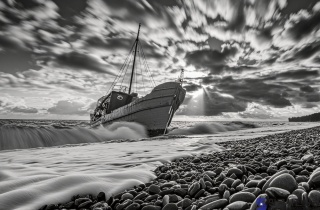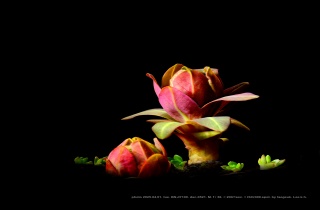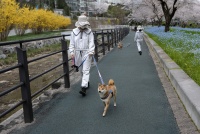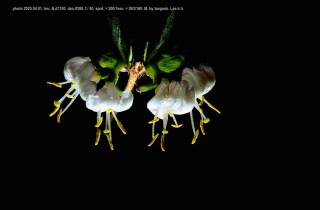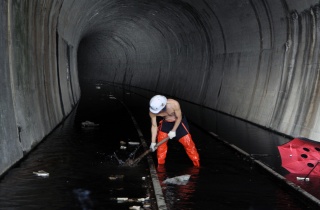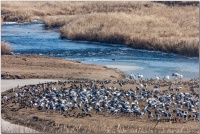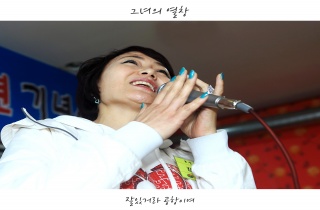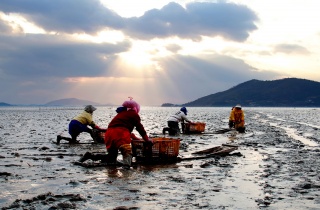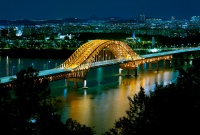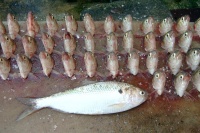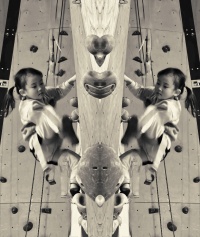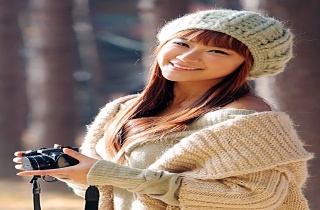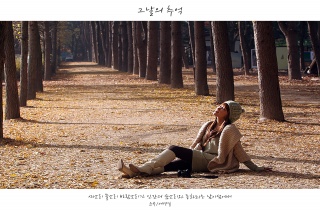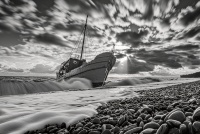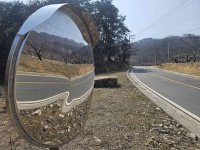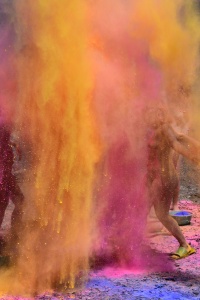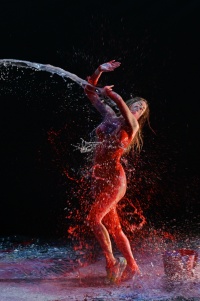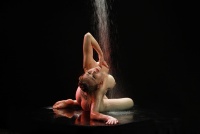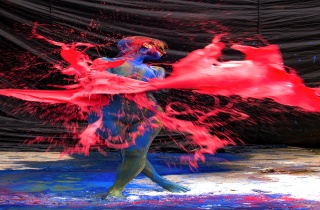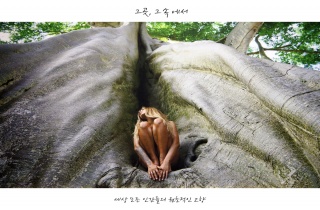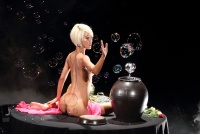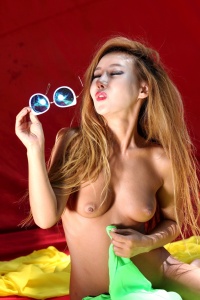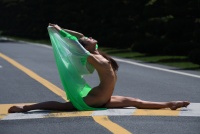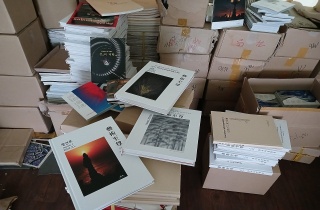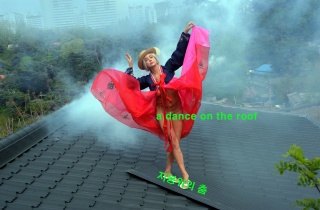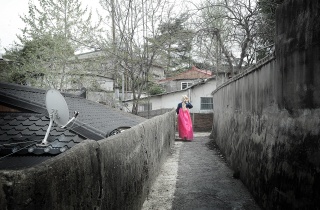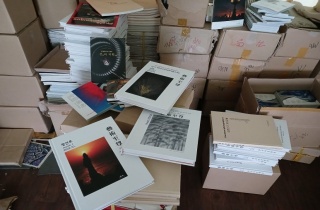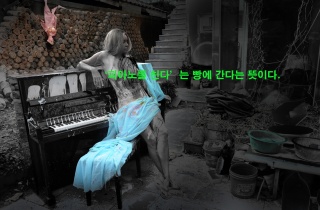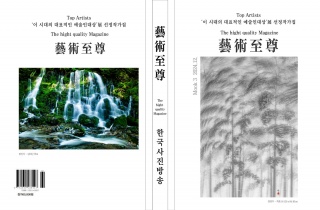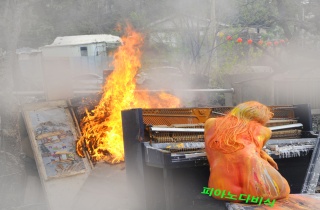[한국사진방송]정태만기자= 40주년을 맞이하는 한국최초의 아트페어 화랑미술제 오픈하다.
2022년 화랑미술제가 143개의 갤러리와 800여명의작가 4,0000여점의 작품들로 3월17일부터 20일까지 4일간 학여울역 세택(SETEC)1.2.3.관에서 열리고 있다.
이번 미술제는 다양하고 이색적이며 젊은 작가들이 많아 볼거리가 많다.
특히 이번전시에 완판을 한 갤러리 반디트라소(BANDI TRAZOS) 권순익(SOONIK KWON)작가를 소개 하려고 한다.
B08호갤러리 반디트라소앞을 지나니 고운 미소를 띄며 인사를 건네오는 안 진옥 대표와규레이트 황경희 씨가 기자를 반갑게 맞이한다.
작품설명을 듣는 중에도 작품구매를 하고 싶다는 분들도 있었지만 작품이 없다고 한다.
주말을 맞이하여 전시장 방문을 추천한다.
예술시장에라도 순풍이 불어오길 바라며~
ARTIST SOONIK KWON
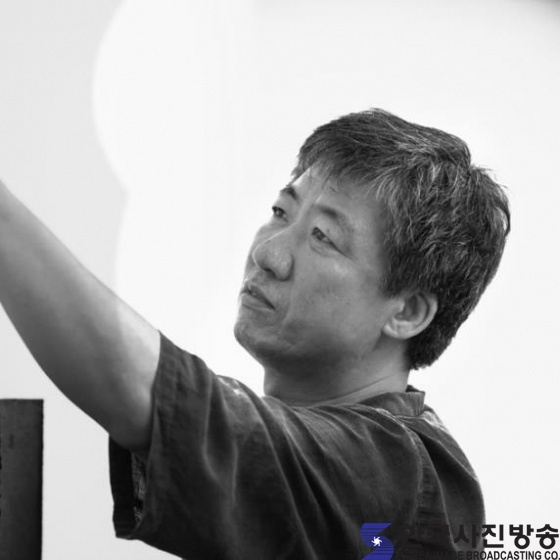
Soonik Kwon is a Korean artist, born in 1959, in Seoul, South Korea.
He is a graduate of Fine Arts Department at the Sejong University.
Soonik has exhibited his works in numerous exhibitions locally and
internationally, mainly in North and South America, but also in Europe.
His mixed mixed media paintings and installations were exhibited more than
30 times in solo exhibitions and more than 50 times in group exhibitions all
over the world. In 2008 he also participated in residency program in Spain
and Jeju Museum of Contemporary Art in Korea. The artist’s oeuvre is in
collections of i.e. Museo Nacional de Arte Contemporaneo (MAC) in Venezuela,
Sungnam Art Center, Cosmo Art Gallery in Spain and Museo de Arte del
Tolima in Colombia as well as numerous private collections in China,
Singapore, Venezuela and Europe.
Born in 1959, Seoul, Korea
B.F.A. Department of Painting, College of Fine Arts, Sejong University.
Solo and Invited Exhibitions
2021 Art Sohyang Gallery, Busan, Korea
2020 Whitewave Gallery, Seoul, Korea
2020 2448 Moon Fine Arts, Seoul, Korea
2020 Jeongsu Art Center, Seoul, Korea
2019 Miaja Gallery, Singapore
2018 Saphira & Ventura Gallery, New York, USA
2018 DYC Gallery, Daegu, Korea
2018 ‘Pile up & Rub’, Youngeun Museum of Contemporary Art, Korea
2017 ‘Absence of Ego’’, Imaginart Gallery, Spain
2016 Gail Art Museum, Korea
2016 Art Sohyang Gallery, Busan, Korea
2016 La ausencia del ego ’’, Museo de Arte Moderno Juan Astorga Anta ””(MAMJAA), Merida, Venezuela
2015 UNC gallery, Seoul, Korea
2015 Museo de Arte contemporaneo del Zulia, Venezuela
2015 Museo de Arte Contemporáneo de Caracas, Caracas, Venezuela
2014 ‘Absence of Ego’’, Palais de Seoul, Seoul, Korea
2013 Art Sohyang Gallery, Busan, Korea
2011 Whitehall Gallery, Seoul, Korea
2011 Let s Play ! Let s get inspired ! !’’, Mokin Museum, Seoul, Korea
2011 LGM Arte International, Bogota, Colombia
2011 Lectura de la Metafora ’’, Espacio de UBS Punta del Este, Uruguay
2011 MYRA Gallery, MIAMI, USA
2010 Metaphorical Time ’’, Baik Song Gallery, Seoul. Korea
2010 Lectura de la Metafora Museo de Arte del Tolima, Ibague, Colombia
2010 Lectura de la Metafora ’’, Museo de Arte Contemporaneo de El Pais , Montevideo, Uruguay
2009 Art Figuratif , Art Seoul Center, Hangaram , Seoul. Korea
2008 Read ’’, Baik Song Gallery, Seoul. Korea
2007 Gallery Hankook IlBo , Seoul, Korea
2006 Gallery Jorge Ontiveros, Madrid, Spain
2005 Art Seoul, Seoul Art Center, Hangaram , Seoul, Korea
2005 Indeco Gallery, Seoul, Korea
2004 Kepco Plaza Gallery, Seoul, Korea
Selected Group Exhibition
2022 Epoch Art Museum, China
2021 ART021 (WHITESTONE GALLERY), Shanghai, China
2021 Miaja Art Colletion, Singapore
2020 Saphira & Ventura Gallery, New York, USA
2014-2020 KIAF(Korea International Art Fair), COEX, Seoul, Korea
2019 Art Sohyang Gallery, Busan, Korea
2019 Saphira & Ventura Gallery, New York, USA
2018-2014 KIAF(Korea International Art Fair), COEX, Seoul, Korea
2018 CONTEXT New York, New York, USA
2018 ART BUSAN, Busan, Korea
2017 CONTEXT Art Miami, Miami, USA
2017 Korea Galleries Art Fair, COEX, Seoul, Korea
2016 SCOPE Miami Beach, Miami, USA
2016 Yangpyeong Art Museum
2013 Art Paris Art Fair, Paris, France
2013 Art Stage Singapore, Singapore
2012-2009 KIAF(Korea International Art Fair), COEX, Seoul, Korea
2011 SH - The Asia Pacific Contemporary Art Fair, Shanghai, China
2011 AHAF SEOUL - Asia TOP Gallery Hotel Fair, Seoul, Korea
2011 SCOPE Art Fair, New York, USA
2011 MIA Miami International Art Fair, Miami, USA
2011 Taipei Art Fair, Taipei, Taiwan
2010 Seoul Open Art Fair, COEX, Seoul, Korea
2010 Shanghai Art Fair, Shanghai, China
2009 Comparaisons, Grand Palais - Champs- Elysées – Paris, France
2009 ICAA Seoul International Art Fair, Chosun ilbo Gallery, Seoul, Korea
2009 Shanghai Art Fair, Shanghai, China
2008 ‘2008 Beijing Olympic International Exchange Exhibition’ Xian, China
2008 Art Madrid, Madrid, Spain
2008 ‘Monthly Chosun, Selected by Critics, 55 Contemporary Korean Artists’, Seoul Art Center, Hangaram, Seoul, Korea
2007 ‘Encuentro Cultural’, Galeria Jorge Ontivero, Madrid, Spain
2007 ‘2007 en Siguenza’, Cosmo Arte Gallery, Alicante Spain
2006 Exchange culture Exhibition of Korea-USA, Washington, USA
2005 Gallery Espacio, Caracas, Venezuela
2005 Fiaam Art Fair, Maracaibo, Venezuela
2005 Exchange Culture Exhibition for the year of Korea, Germany
2005 Exchange Culture Exhibition, Taean, China
2005 FIA International Art Fair, Caracas, Venezuela
2003 ‘Fine Arts Festival of the 60 Artists for the peace’, National Modern Art Museum Gwacheon
2002 ‘Flag Art Festival for 2002 FIFA World Cup’, World Cup Park, Seoul, Korea
2002 ‘Flag Festival, Buenos Aires-Seoul’ National Museum of Fine Arts, Buenos Aires, Argentina.
Selected Group Exhibition
2018-2014 KIAF(Korea International Art Fair), COEX, Seoul, Korea
2008 Shanghai Art Fair, Shanghai, China
2008 KIAF(Korea International Art Fair), COEX, Seoul, Korea
2008 Singapore Art Fair, Singapore
2006 ‘2 Korean Artists’, Gallery San Alfonso, Valparaiso, Chile
2004 ‘1st Jeju International Free Art Festival’, Seogwipo Kidang Museum, Jeju, Korea/ Los Angeles Gallery ASTO, LA, USA
2000 ‘Japan-Korea International Exchange Art Exhibition’, Gallery Daerim Art, Seoul, Korea
2000 ‘Hope for flowers’ Youngdeong-Po Culture Center, Seoul, Korea
Residency Program
2008 Cosmo Arte Gallery, Spain
2010 Jeju Museum of Contemporary Art, Korea
2017 Youngeun Museum of Contemporary Art, Korea
Collections
Korea National Diplomatic Academy, Korea
Museo de Arte Contemporaneo del Zulia, Venezuela
Museo Nacional de Arte Contemporaneo Caracas, Venezuela
Museo de Arte del Tolima, Colombia
Epoch Art Museum, China
Taepyungyang(Construction company)
Sungnam Art Center
Pakyoungsa (Publishing company)
Hankukilbo (Newspaper)
The Haitai Confectionery and Foods Co., Ltd
LG Chemistry
OCI Company Co., Ltd
Cosmo Arte Gallery, Spain
Private Collection- Singapore, Venezuela, China
A Review of Kwon Soonik’s Art
Transition from ‘Self’ to ‘No-self’, Flesh-like Traces of the ‘I’
Kho, Chung-Hwan, art critic
‘Hoping Your Wishes Come True Year After Year.’ Here, the word year is used twice as a means of emphasis as well as to indicate a constancy rather than a specific year. In other words, this title implies a desire for wishes to be fulfilled at all times. It directs such desire at oneself as well as at others. It implies positive energy and a peaceful state. And this gives rise to peace of mind. All wishes fulfilled, a peaceful state, and the consequent peace of mind are emphasized in a gradual manner towards a final climax. This is why we see a repetition of the word year. Then, ‘Stroll’. This refers to a state where we put our minds at rest and just take a walk. Thus, the meaning of the word stroll has to do with the above mentioned ‘wishes fulfilled’ and ‘peace of mind.’ A state where our minds are at rest and devoid of desires is the common feature that runs throughout Kwon Soonik’s works. He projects his own sense of identity and self-perception onto the words ‘‘Hoping Your Wishes Come True Year After Year’ and ‘Stroll.’
In his works, this self-awareness is expressed through the man in white clothes. The man may be a self-portrait of the artist himself or an anonymous portrait of all of us. Perhaps, the man hanging out with the tiger and playing with the fish is a mythical character that crosses the boundary between man and nature. Like this, the artist’s former works convey mythical messages through paintings that look like scenes from a folktale. They are flat, stylized, and simple paintings that seem to send the viewers positive energy, and wish them a peaceful life. The myth is Utopia, a place that does not exist in real life but only in people’s minds, and that may or may not even exist. Where is this place? It is Africa, its abstract equivalent being the mind. Elements of a folk painting are added to his works after his trip to Africa. Here, Africa should be seen as a place existing in the painter’s mind and as a Utopia, rather than as a real place. Here, the ‘stroll’ is called upon again. His paintings are a depiction of his state of mind, and so we can all take a stroll through his mind.
Like this, the artist has expressed an awareness of his ‘self’ in his paintings. The manifestation of his self is particularly evident in the painting where we see the capital ‘I’ and the small letter ‘i’. The letters I and i imply a distinction between the bigger self (macrocosm) and the smaller self (microcosm), which is equivalent to existence (the universal) and being (the individual) formulated by Heidegger. The artist attempted to blur the line between the bigger self and the smaller self, the macrocosm and the microcosm, existence and being, and the universal and the individual, ultimately trying to depict the state of mutual interaction and interference between these different elements. Like this, his former works contain elements of folktales and folklores. They are mythical and utopian. Through these self-reflecting processes, he has laid the groundwork for his later works.
Then a major shift takes place in his art. This change, which can only be described as revolutionary, occurs around 2010. To be more specific, the figurative style gives way to a more abstract expression. Organic images are replaced by geometric shapes. He rejects the use of vibrant colors to fill his works with monochromatic colors. He.
refrains from an accurate reproduction of a subject, and focuses on internal and abstract expressions. Does this mean that the artist’s ‘self’ is absent from his latest works? Are his recent abstract works simply a result of his immersion in the formal logic of art? No, they are not. The representational forms and expressions of his former paintings have simply merged into the formal logic of his later works. Thus, we should see his latest creations as sediments or dregs left from such blending. This is why his latest works have been described as internal and abstract.
The artist has called his latest series of works Absence of Ego-Return, Absence of Ego-Shadow, Absence of Ego-Mirage, and Absence of Ego-Mirror of Mind. Except for the last one, which is an installation of Korean traditional tiles, the rest are all paintings. It’s a series, composed of a number of distinct paintings with small, but not decisive, differences. Each one of these paintings deals with the absence of the ‘self’. In other words, the ‘I’ does not exist. Did the artist exclude the ‘I’ from his latest works? Is the absence of the self -a state in which ‘I’ is nowhere to be seen- ever possible? Is it a state that has overcome the ‘self’? Is the ‘self’ something to be overcome? Then, did the artist move from the state of ‘self’ to the state of ‘no self’ to finally reach a state where the ‘I’ does not exist? To be exact, he is still on his way to that state and has not reached it yet. And his works serve as a road along which to complete that journey. In other words, the ‘Absence of Ego’ series is the result of his struggle to achieve the no-self state, and a record of the various experiences he has gone through during the process. Thus, the absence of I takes the form of Return, Shadow, Mirage, and Mirror of Mind.
Let’s take a look at ‘Return’ first. Does this mean a return to the ‘self’, or a return to the state of ‘no-self’? Or does it mean a return to what in Buddhism is called ‘true Atman’ (one’s true self)? Most probably, it is a state that, to a certain extent, encompasses all that and beyond. It may be a state in which we take off our persona (masked individual) and recover our identity (the individual behind the mask). Or it may be a state where we shed ourselves of our identity and grab onto the non-identity, transforming and renewing ourselves at every moment.
It may be the original shape of our existence that renews itself every moment. The ultimate. Our true nature, which is the mirror of the mind. And in that mirror of the mind, I see myself as shadow and as mirage. I follow a shadow and chase a mirage, both of which are a reflection of the I. Therefore, I am the shadow and the mirage. I am an illusion and a hallucination. I am the waves dispersing serenely on the water surface, the wind that shakes tree leaves, and a planet wandering in the pitch dark night. I am the breath and respiration. I am the energy and flow drifting around aimlessly. I am the trace, stain, and mark. Thus, the ‘Absence of Ego’ series is a portrayal of the transition from ‘self’ to ‘no-self’, the infinity which I inch towards each and every moment. Therefore, the artist did not paint an absence but a presence of the ‘I’, and he did so in a desperate way. In other words, what appears to be an absence of self is, in fact, a desperate attempt to prove its existence.
His pictures are filled with countless dots or spots, which have been created through the following process. First, he does an underpainting on a surface and draws small grids on it. These grids serve as frames in which to draw rounded dots. One dot at a time, and one dot for one grid, until all the grids are filled with dots. Then, fine sand or soil is mixed with pigments, after which the artist uses a knife to apply the resulting material on the pre-made dots. But rather than simply spreading the material on the dots, he piles up several layers of this uniquely made paint on top of each dot until he creates a new dot of a certain thickness. Finally, he rubs the surface of these
raised dots with graphite (a pencil, in fact) to obtain that dark, deep color of coal and the shiny texture of a metal. Of course, he does not use exactly identical methods for all of his works, but I can safely say that the process is roughly the same. He makes small changes to this basic form by using a slightly different color, altering the positions of the dots, or even overlapping the surfaces of some dots. Still, most of them are monochromatic and seem to be expressing an internal and abstract theme.
Do these paintings and work methods have anything to do with the theme ‘Absence of Ego?’ I mean, how does the artist achieve the state of no self? How do form and content of his works fit in with each other? As I have described above, his work method involves an endless repetition of a series of steps, like drawing grids, filling them with dots, piling on them new dots, and polishing them up with graphite. This process follows a set of rules and in doing so the individual (the artist) disappears. The artist serves only as a supporting role that helps create an environment for the procedure and rules to finish the painting. And, once again, the individual vanishes in the process. Through this process in which the ‘self’ disappears and vanishes, the painting paints itself.
It may sound like a play on words, but it is not. The boundary between the creator and the created crumbles down, and the two merge with each other. In other words, the ‘self’ that seems gone from the surface has, in fact, fused with the painting to become an integral part of it. The absence of self is, therefore, the name given to the emptiness that is left after the entire ‘self’ has blended with the painting. Thus, just like the artist had projected his ‘self’ onto his early works, he is projecting the absence of his self in his recent works. To achieve such a state of no self, the drawing process should be free from anguish or desire. There should be only transparent flesh-like traces of an abstract self. Like this, the artist’s works show the state where the self becomes perfectly transparent, the state where the self disappears from view, the transition from ‘self’ to ‘no self.’ In a word, he has drawn the flesh-like traces and marks of his self.
The artist has painted the different points of his transition from the self to the no-self. And he has presented a full spectrum of a microscopic and macroscopic existence in the form of dots, stains, marks, traces, flesh, islands, planets, and dust.
Encounter with the Korean artist KWON SOON-IK
An Austrian perspective
I
Meeting Kwon Soon-Ik leaves a very strong impression. A quiet and gentle man, who convinces instantaneously as a profound human being and artist. Describing him is describing his art: there is a quality of meditative tranquility, peacefulness and profoundness that define both, the artist and his work.
Kwon’s works of art are profound and meditative in the sense that they deal with essential questions of human existence. The artist’s creative process is strongly influenced by his philosophical contemplations. In his paintings he reflects the contradictions, opposites and contrasts that mark human life through the antipodes of visibility and non-visibility, appearance and reality, connection and separation. He publishes his works in thematic series and each series focuses on one or the other of those aspects.
His very early works show concrete objects, such as a pair of chairs that form a kind of dialogue through the way they are displayed in light and shadow. Another painting of his early period displays a door lock which can be seen as a key to a different space. A Buddhist image which is the central motive of a work can be interpreted as an opening to a superior world. His more recent creations do not contain figurative elements anymore, whereas the technique and the materials the artist uses in his paintings have stayed the same ever since. All his artworks impress by an elaborate and perfect execution.
II
The series Absence of Ego, with its sub divisions Return, Shadow, Mirage and Mind Mirror, marks the artist’s step towards abstract art. The first three sub-divisions are paintings, while Absence of Ego – Mind Mirror consists of installations using black traditional Korean roof tiles. The central elements in the paintings of this series are dots and circles. Countless circles and dots are placed into a grid, sometimes more dots are piled on top of each other before they are finally polished with black pencil graphite.
The Absence of Ego series appears to be the turning point in the artist’s career where his reflections on human existence and his philosophy concerning his destination as a human being become one with the creative process of his work. By the endless and trance-like repetition of the technique and process that make up this series, he tries to reduce his individuality and to disconnect from his ego. He desires to achieve a non-self-state in order to become one with a superior order. In the artist’s opinion when being able to forget about one’s own reality, reasoning and emotions and disconnecting from one’s individuality, a human being can connect to eternity. Only when entirely taking back the individual self, becoming one with the universe is possible. With its incessant repetition Kwon’s creative process of painting can be seen as his resolution and struggle to minimize his self in order to become one with a bigger entity.
In order to achieve fulfillment in life western philosophies and beliefs focus on the individual. Following Asian tradition Kwon seeks a different approach.
Kwon Soonik was at some point in his artistic career strongly influenced by the Korean ceramic tradition of Buncheong which is famous for decorating ceramic objects with circles and dots. It is therefore not surprising that the artist resumes on the elements of dots and circles at a later point in his artistic evolution.
The circle may be regarded as a symbol of life. There is no beginning nor end in a circle, again a hint to the universe and eternity to which the artist wants to connect through the process of his art.
III
In another of his series, titled The gap in between – Pile up and Rub, the artist applies several layers of different colours on top of each other. By doing so he gives form to square or rectangular planes of colour separated by a cleft. He fills the narrow gap of the cleft with finely ground pencil graphite and rubs it until it displays its unique gloss. The layers of pigment are necessary in order to create the final colour appearance of a plane. They are still visible at the rims of the plane hinting at how the colour is composed. Fine lines cross the coloured planes, sometimes horizontal sometimes vertical, thus breaking the evenness of the surface.
There is a relationship, even a dialogue among the planes that are separated by the “gap in between”. Sometimes the colours of the planes in one painting are shades of one basic colour, like various blues, greens or reds. In other cases, one painting shows strongly opposed colours like green and red.
According to the artist the layers of colour symbolize the layers of time whereas the cleft separating them hints at the present, the ephemeral moment which unites the past and the future.
IV
In his most recent works Kwon opens a “window” in the center of a painting. It leaves the spectator with the impression that a square was cut out of the canvas and folded up like a piece of paper. The “cut-out space” appears to be empty, while into the space which represents the “folded-up part” pencil graphite is rubbed. The regard is clearly concentrated on the two squares right in the center of the painting, the surrounding part, monochrome, being of subordinate importance. One feels like being drawn into the contrast of the emptiness of the raw canvas and the almost black of the pencil graphite. The attention is not distracted by a mixture of other colours.
These recent works symbolize the process of unveiling something which is normally hidden away, of making visible what usually is invisible. Buddhism attempts through its practices to remove the mask human beings wear, to unveil their real identity and to detect the very nature of the individual.
The colours Kwon chose for these latest works are identical with the five colours which, in the ancient Korean perception, make up the universe: yellow stands for the center, black for the North symbolizing winter, blue for the East symbolizing spring, red for the South symbolizing summer, and white stands for the West symbolizing autumn.
V
Kwon studied painting at the Sejong University’s College of Fine Arts in Seoul and started his artistic career as a painter. Giving in to his attraction to ceramics, soon he shifted the emphasis to the creation of ceramic objects for about ten years. Although he still produces stunning installations and sculptures in ceramics, his focus has now switched to painting again. The method and way of expression allow to discern his indulgence to plastic art though as he treats the even surface of a painting accordingly: by applying the pigment richly and in layers he achieves a relief shape. This is the case in most of his series, be it the dots and circles in the Absence of Ego series where the points are actually protruding from the painting, or be it the gap in the The Gap in between- Pile up and Rub series where the colour patches produce an elevation and the gap in between becomes a three-dimensional cleft.
Kwon’s art makes a distinct development visible and continues to further evolve. Even though each of his creations displays an individual touch that enables to tell immediately that a piece of art is his. There is no visible influence by an art movement or another artist, be it Korean or foreign. Using elements of traditional Korean culture for his art he has accomplished his personal style that is unique both with respect to technique and form of expression.
|

